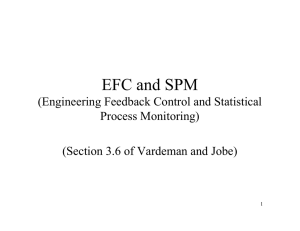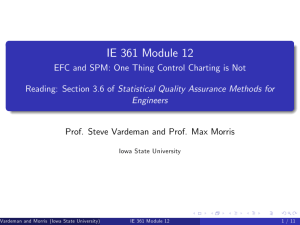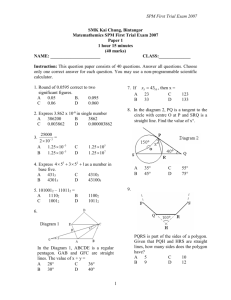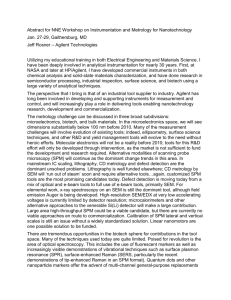IE 361 Module 12 EFC and SPM ... One Thing Control
advertisement
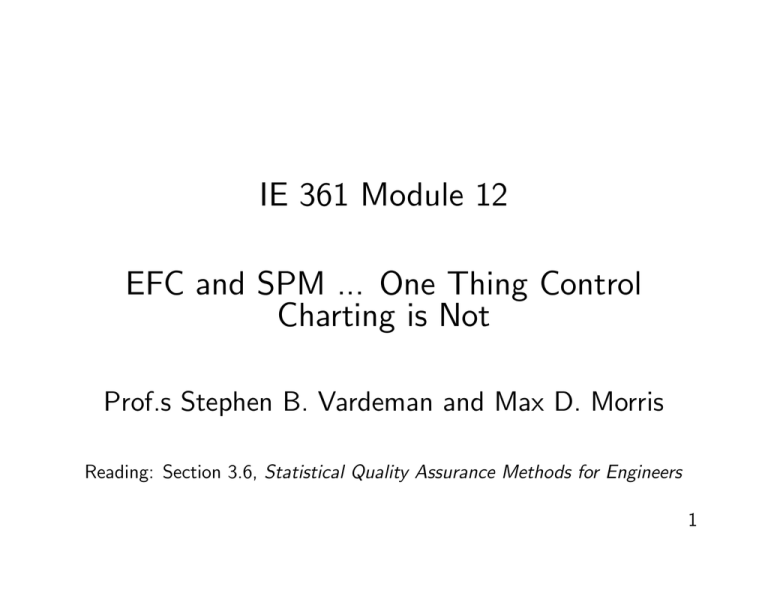
IE 361 Module 12 EFC and SPM ... One Thing Control Charting is Not Prof.s Stephen B. Vardeman and Max D. Morris Reading: Section 3.6, Statistical Quality Assurance Methods for Engineers 1 In this short module, we try to make explicit the difference between "engineering control" (as, for example, understood by EE’s and ME’s) and "SPC." Recall from Module 10 the basic insight that Shewhart "control charting" is about process watching for purposes of change detection as illustrated in the figure below repeated from that module. Figure 1: Statistical Process Monitoring 2 EFC and SPM (Control Charts are NOT ProcessTweaking Tools) Engineering Feedback Control is process guidance/on-line adjustment. Figure 2: Schematic of an Engineering Control Scheme 3 This is not the same thing as process watching for purposes of change detection. SPM and EFC are NOT Competing Technologies • both have their places • both can be badly done • both can contribute to variation reduction in an industrial process • neither is a "weak version" of the other 4 In many applications EFC creates the physical stability that SPM monitors EFC "automatic" compensation-oriented expects process "drift" on-going "tweaking" typically computer controlled maintains optimal adjustment tactical can exploit models SPM often manual detection-oriented expects "stability" triggers intervention typically a human agent intervenes warns of "special cause" changes strategic warns of departure from model The technologies of EFC and SPM are quite different. SPM deals in "control charts" (Shewhart and others). EFC deals in feedback algorithms that prescribe how adjustment variables are to be manipulated on the basis of process data. "PID" control algorithms are a common variety of these (see Section 3.6 for a few details on PID control). 5 Example (Paper Making from Section 3.6 of SQAME ) Prof. Jobe worked with the Miami U. Paper Science Department on the control of a paper-making machine. Figure 3: Schematic of a Paper-Making Process 6 Issues in developing an appropriate control algorithm included: • pulp mix thickness WILL vary, but pump speed can be used to compensate • this is NOT an SPC problem! (it is an automated compensation problem) • target paper density is 70 g/ m2 • 1 "tick" on pump dial changes density about .3 g/ m2 • time delay and potential for over-compensation/oscillation are serious issues 7 To remove the time delay issue, a 5-minute sampling/adjustment interval was adopted. Through a series of experiments, an appropriate PID control algorithm was developed (see SQAME exposition and problems and the appendix to this module for details). The following shows "uncontrolled"/baseline density data for 12 periods and data from 6 periods after the final algorithm was implemented and had been allowed to take effect. Figure 4: "Before" and "After" Paper Density 8 To this point, we have an EFC success story. SPM now could have a role in monitoring for unexpected changes from this behavior. Appendix (Some Details on a PID Controller for the Paper Machine) A PID (proportional/integral/derivative) control algorithm for the paper making example is ∆X (t) = κ1∆E (t) + κ2E (t) + κ3∆2E (t) 9 for Y (t) = measured paper density at time t ∆X (t) = the knob position change (in "ticks") after observing Y (t) E (t) = the "error" at time t = T (t) − Y (t) ∆E (t) = E (t) − E (t − 1) and ∆2E (t) = ∆ (∆E (t)) = ∆E (t) − ∆E (t − 1) The 10 • "Integral" part of the algorithm, κ2E (t), reacts to deviation from target/offset • "Proportional" part of the algorithm, κ1∆E (t), reacts to changes in error (/level) • "Derivative" part of the algorithm, κ3∆2E (t), reacts to curvature on plots of error Jobe’s final control algorithm was ∆X (t) = .83∆E (t) + 1.66E (t) + .83∆2E (t) 11 The following table shows some hypothetical values for Y (t) and computation of corresponding values of ∆X (t) for Jobe’s control algorithm. t T (t) Y (t) E (t) ∆E (t) ∆2E (t) ∆X (t) 1 70.0 65.0 5.0 2 70.0 67.0 3.0 −2.0 3 70.0 68.6 1.4 −1.6 .4 1.328 4 70.0 68.0 2.0 .6 2.2 5.644 5 70.0 67.8 2.2 .2 −.4 3.486 6 70.0 69.2 .8 −1.4 −1.6 −1.162 12
